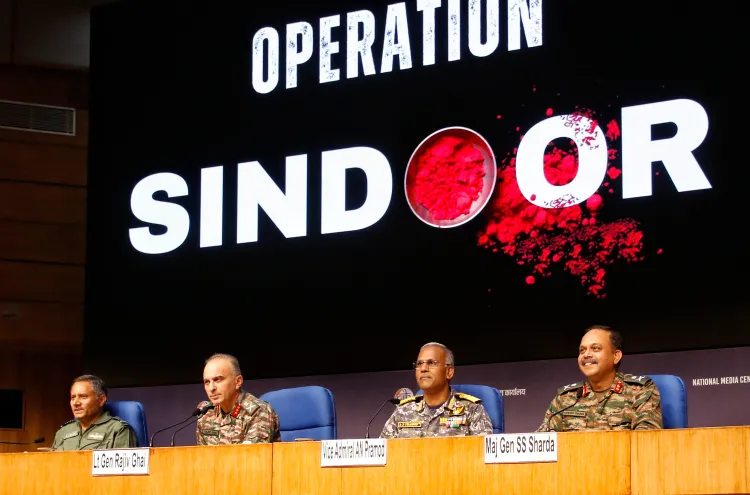What Achievements Did Operation Sindoor Bring to India?

Synopsis
Key Takeaways
- Nine terror camps neutralized
- Deep strikes into Pakistan's territory
- Red line established against state-sponsored terrorism
- Precision strikes without civilian targets
- International support for India's actions
New Delhi, May 11 (NationPress) Following the shocking April 22 Pahalgam terror attack, India executed a significant military operation deep within Pakistan and Pakistan-occupied J&K during the early hours of May 7. This strike aimed at terror launchpads to avenge the cruel killings of its civilians. The outcome of this operation has been nothing short of triumphant. Let's explore the achievements of India.
Nine Terror Camps Neutralized
India successfully dismantled 9 crucial terror launchpads situated in Pakistan and PoK. The targets were affiliated with Lashkar-e-Taiba, Jaish-e-Mohammed, and Hizbul Mujahideen. These locations were recognized as pivotal training and operational centers for planning attacks against India.
Deep Strikes into Pakistan's Territory
India has altered the rules of engagement, demonstrating readiness to strike deep into Pakistan's territory. The operation dispelled the myth that terrorists and their supporters operate separately, targeting both and marking a shift in strategy.
Strikes extended well beyond just PoJK, reaching hundreds of kilometers into Pakistan, including the Punjab province, which is a strategic bastion for the Pakistani military.
Sensitive terror hubs like Bahawalpur were targeted, areas that even the US had previously avoided for drone strikes, according to sources.
India has established that neither the Line of Control (LoC) nor any internal geography of Pakistan is off-limits if terrorism originates from there. Through its actions, India has conveyed to the world that every inch of Pakistan is within reach.
Red Line Established
India’s response marks a strategic pivot toward a more calibrated deterrence model. Operation Sindoor has drawn a definitive line that Pakistan can no longer overlook—state-sponsored terrorism will incur direct, visible repercussions.
New Approach to Counter-Terrorism
For the first time, India has decisively blurred the lines between terrorists and their sponsors, taking action against both. This undermines the long-held belief that certain rogue elements within the Pakistani state could conduct terrorist operations without consequences.
Pakistan's Air Defence Vulnerabilities Exposed
Indian forces effectively bypassed or jammed Pakistan’s air defense systems. The swift execution of the strikes, conducted within a 23-minute window, revealed significant gaps in Pakistan's air defense capabilities.
Equipped with SCALP missiles and HAMMER bombs, the Indian Rafale jets executed the mission with zero reported losses, showcasing both technological and strategic superiority.
Projection of India's Air Defence Preparedness
India demonstrated its advanced air defense capabilities and effectively secured its airspace with a robust, layered architecture. It successfully penetrated the Chinese-made systems deployed by Pakistan, emphasizing that defense is more about integration than mere acquisition.
The Akashteer Air Defence System proved its effectiveness by neutralizing numerous Pakistani drones and missiles, positioning it as a contender for global export.
Precision Without Escalation
No military or civilian infrastructure was targeted—only terror assets were struck. India adhered to its Zero Tolerance doctrine while avoiding broader military escalation.
Elimination of Key Terror Operatives
Numerous high-profile terrorists were eliminated, including individuals from India’s most wanted list, while the leadership of several terror modules was dismantled in a single night.
Impact on Pakistan’s Military Infrastructure
India’s counter-military actions on the nights of May 9 and 10 marked a historic instance of a nation damaging the air force installations of a nuclear-armed country. Over a span of 3 hours, 11 bases were attacked, including Nur Khan, Rafiqi, Murid, Sukkur, Sialkot, Pasrur, Chunian, Sargodha, Skaru, Bholari, and Jacobabad. This led to the destruction of approximately 20% of Pakistan’s air force infrastructure, according to reports.
India targeted Bholari Air Base, resulting in the deaths of over 50 individuals, including Pakistan’s squadron leader Usman Yousuf and 4 airmen, along with the destruction of Pakistani fighter jets.
Tri-Service Coordination
The Indian Army, Navy, and Air Force executed synchronized strikes, showcasing India’s advancing joint warfare capabilities.
Global Message Delivered
India conveyed a clear message to the world that it will not wait for external permission to safeguard its citizens. Acts of terrorism will be met with consequences—anytime, anywhere.
It also underscored that terrorists and their masterminds have no safe havens. Should Pakistan retaliate, India is prepared to respond decisively.
International Support Gained
Unlike previous conflicts where global leaders urged India for restraint, this time, multiple world leaders expressed support for India’s stance against terrorism.
Changing the Kashmir Narrative
For the first time, the relationship between India and Pakistan was viewed through the lens of terrorism, completely separating it from the Kashmir issue. This separation was achieved through precise strikes conducted during Operation Sindoor, which exclusively targeted terror infrastructure.









